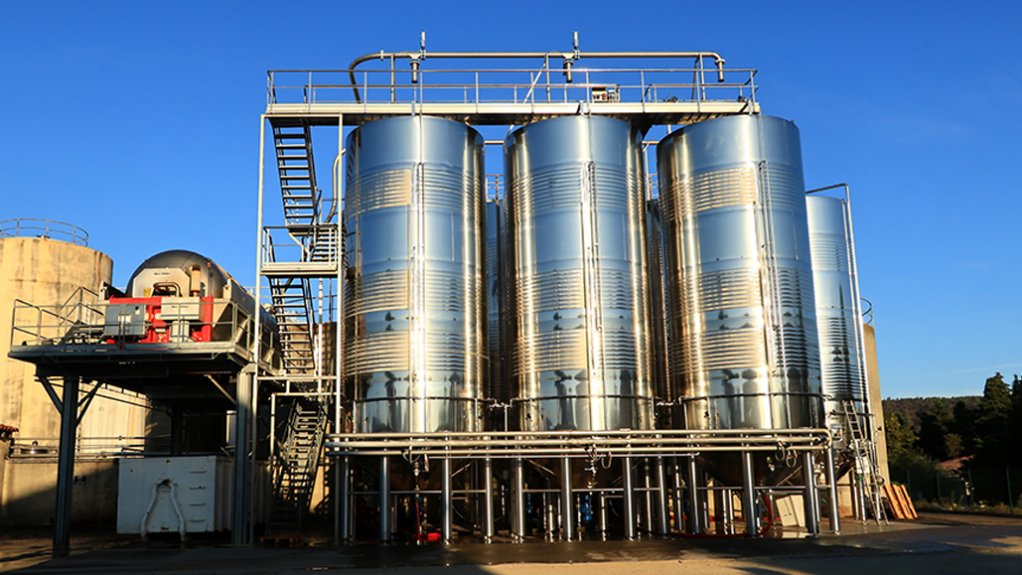Increase in tanks demand presents challenges


AGES LIKE A FINE WINE Over the recommended life span of a structure, stainless steel becomes more economical because of reduced maintenance and refurbishment required
Despite a global increase in stainless steel tanks production over the past 12 months – particularly for the food and beverage sectors – some subsectors are facing challenges, says stainless steel supplier Columbus Stainless market development manager Lerato Mashigo.
“The food and beverage sector continues to grow and, with that, we continue to see positive movements in the fabrication industry to support this growing demand,” she tells Engineering News.
Mashigo notes that, in contrast to the rest of the beverage sector, the South African liquor industry suffered a downturn in activity, owing to the impact of the Covid-19 lockdown regulations. This resulted in major capital investment and expansion projects being halted.
Engineering News reported in January that local alcohol producer South African Breweries has cancelled about R5-billion worth of expansion projects since the Covid-19 outbreak, and about 30% of local breweries have gone out of business.
Dutch brewer Heineken has also abandoned expansion plans, with news outlet Business Report touting a cancelled investment figure as high as R3.5-billion.
Meanwhile, Mashigo says the tank container market is also facing challenges, owing to South Africa’s manufacturing and fabrication industries struggling to remain cost competitive, compared with imported tanks from China.
The cost differential is mainly because of the Chinese government’s generous subsidy strategies, she adds.
Mashigo explains that this remains a challenge in the greater scheme of manufacturing and has a negative impact on the manufacturing downstream fabricators in South Africa, as it is stunting their growth.
Stainless by Choice
Mashigo claims that stainless steel is the preferred metal of choice when manufacturing tanks, especially when used in corrosive applications, because it ensures that the vessels maintain structural integrity in service without risk of failure.
“In the food and beverage industry, for example, materials chosen for processing tanks are required to have hygienic properties. This means that no measurable chemical reaction should occur between the metal surface and the food source to prevent contamination.”
Therefore, stainless steels are considered to have excellent hygienic properties because of their corrosion resistance.
Mashigo says stainless steel is considered to be expensive upfront, compared with other metals, which is a deterrent for some projects, owing to budget constraints.
However, she urges decision-makers to look at the bigger picture.
“The initial material cost of stainless steel is generally higher than that of competing metals, but over the life span of the tank or vessel, stainless steel is considered the most cost-effective metal.”
Mashigo’s argument is rooted in the concept of life-cycle costing, which is a useful tool that takes into consideration the initial material cost, fabrication costs, maintenance and refurbishment costs, the cost of lost production because of downtime, as well as possible replacement costs over a defined product’s life span.
“Ultimately, over the recommended life span of a structure, stainless steel becomes more economical, with reductions in lost production because of less maintenance and refurbishments, while maintaining longevity and structural integrity of the vessels in service,” she explains.
Getting Good Grades
Mashigo emphasises that it is important to use the correct stainless steel grade in any application to reap the benefits of longevity and structural integrity in service.
Stainless steel grades are classified into different categories based on their microstructures, which are influenced mainly by their chemical compositions.
Stainless steels are essentially alloys of iron and chromium, with additions of nickel, molybdenum and other alloying elements to provide specific properties that determine the degree of corrosion resistance, strength, formability and other operational performance factors.
The three main categories used in the fabrication of numerous tanks and vessels are ferritic, austenitic and duplex stainless steels.
Ferritic stainless steel types are commonly known as plain chromium steels. They exhibit good corrosion resistance and are resistant to stress corrosion cracking.
Mashigo says they function well in ambient to moderately high temperature applications. Weldability is limited to thinner sections less than 3 mm thick, owing to excessive grain growth, which can result in brittle welds.
Austenitic stainless steel, commonly known as nickel-containing steel, has excellent formability and fabricability, including much better weldability. This grade exhibits good strength properties in sub-zero temperatures, such as in liquefied natural gas processing, storage and transportation vessels, and in very high temperatures such as in chemical processing tanks.
“Austenitic stainless steel also exhibits excellent high-temperature oxidation resistance and is able to withstand high-pressure applications. This grade is used successfully in a range of industries, including food and beverage, oil and gas, as well as chemicals and petrochemicals,” Mashigo states.
The high-strength duplex stainless steel grades contain a mixed microstructure of austenite and ferrite. They have higher resistance to cracking from corrosion stress than the austenitic grades and have superior corrosion resistance.
“Their superior corrosion resistance can withstand even harsh marine environments. Successful applications are, therefore, mainly seen in processing and storage tanks for the mining, chemical and petrochemical industries,” Mashigo explains.
Owing to duplex stainless steel grades’ improved resistance to stress corrosion cracking, they are also used extensively in hot water systems.
To ensure that the stainless steel tank manufacturing sector remains competitive, Columbus Stainless technical team continuously supports the industry with guidance regarding stainless steel enquiries.
Article Enquiry
Email Article
Save Article
Feedback
To advertise email advertising@creamermedia.co.za or click here
Comments
Press Office
Announcements
What's On
Subscribe to improve your user experience...
Option 1 (equivalent of R125 a month):
Receive a weekly copy of Creamer Media's Engineering News & Mining Weekly magazine
(print copy for those in South Africa and e-magazine for those outside of South Africa)
Receive daily email newsletters
Access to full search results
Access archive of magazine back copies
Access to Projects in Progress
Access to ONE Research Report of your choice in PDF format
Option 2 (equivalent of R375 a month):
All benefits from Option 1
PLUS
Access to Creamer Media's Research Channel Africa for ALL Research Reports, in PDF format, on various industrial and mining sectors
including Electricity; Water; Energy Transition; Hydrogen; Roads, Rail and Ports; Coal; Gold; Platinum; Battery Metals; etc.
Already a subscriber?
Forgotten your password?
Receive weekly copy of Creamer Media's Engineering News & Mining Weekly magazine (print copy for those in South Africa and e-magazine for those outside of South Africa)
➕
Recieve daily email newsletters
➕
Access to full search results
➕
Access archive of magazine back copies
➕
Access to Projects in Progress
➕
Access to ONE Research Report of your choice in PDF format
RESEARCH CHANNEL AFRICA
R4500 (equivalent of R375 a month)
SUBSCRIBEAll benefits from Option 1
➕
Access to Creamer Media's Research Channel Africa for ALL Research Reports on various industrial and mining sectors, in PDF format, including on:
Electricity
➕
Water
➕
Energy Transition
➕
Hydrogen
➕
Roads, Rail and Ports
➕
Coal
➕
Gold
➕
Platinum
➕
Battery Metals
➕
etc.
Receive all benefits from Option 1 or Option 2 delivered to numerous people at your company
➕
Multiple User names and Passwords for simultaneous log-ins
➕
Intranet integration access to all in your organisation



















